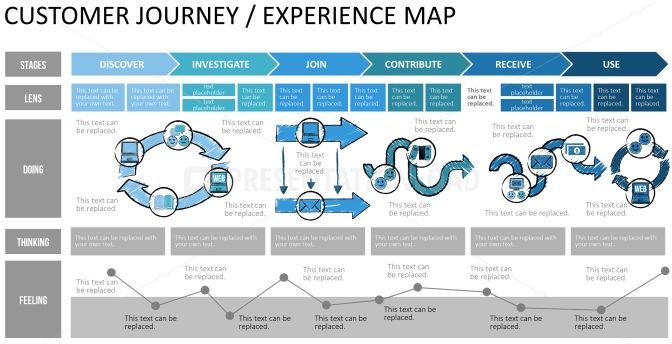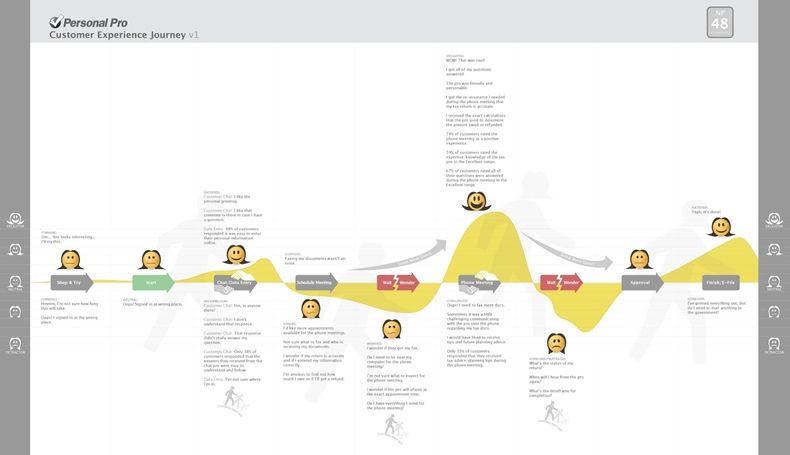Remember the early days of getting directions online? You'd go to a site like MapQuest, put in your start and end points, and print out 10 pages of turn-by-turn directions. It worked great... until you missed a turn. If you got off the route, you were doomed.
Compare that early tech to a current, GPS-based service, such as Google Maps—or today's MapQuest... It gives you dynamic directions in real-time. It knows where you are, how fast you're going, and where you're headed. It can even warn you of road hazards and find new routes on the fly.
Which version of navigation are you using to track your customers' journeys? Are you spitting out a set of directions for them to follow, hoping they won't deviate from the route? Or are you using accurate data to map where they are, where they're headed, and what hazards they need to avoid?
Marketing technology makes it possible to map the customer journey in far more detail than ever before. And a more accurate customer journey map can guide your marketing to be more strategic, better optimized, and ultimately more effective.
Here's how to create a better customer journey map to refine your campaign objectives.
Why a Customer Journey Map Matters
The process of creating a data-driven customer journey map will help you identify the touchpoints where your marketing influence is most critical. You can then redesign your campaign to address the most meaningful touchpoints, and adjust your objectives to reflect the changes.
Attribution and measurement are also easier with a more accurate customer journey map. You'll be able to see at a glance what interactions and outcomes are the most valuable in contributing to a conversion. Just make sure to plan for measurement as you plan your campaign.
How to Create a Customer Journey Map
A customer journey map is a data-driven visualization of how the majority of your most valued customers move through the buying process. Here's how to build yours.
1. Consult stakeholders from multiple departments
Many organizations are trying to break down silos and improve communication. And for good reason: A full 360-degree view of the customer requires more data than just the marketing department can provide.
Talk to Sales, Customer Service, even Procurement and HR. Each department has crucial data that can help complete your map.
2. Identify key touchpoints
Look for the inflection points in your data—places where customers could be persuaded to veer off toward a competitor's solution.
- Do they choose a competitor after attending a convention?
- Do they give up on your hard-to-navigate home page and go back to the search engine?
- Do they hear a competitor's ad on a popular podcast?
Inflection points vary widely, and they will be different for every organization. Let the data guide you to the opportunities for your marketing to truly make a difference.
3. Use data to tell a story
A map can be a narrative. Think of the old Family Circus cartoons with the dotted line tracing Billy's journey, or the map of Middle Earth in Lord of the Rings. Your customer journey map should aim to tell a story, too.
Moreover, the map should trace the emotional journey as well as the business journey. Emotions, after all, are what ultimately guide our actions.
The following map from Intuit is a good example of how to map the emotional plot points of the journey. Note how the yellow line traces the overall mood of a customer throughout, with the emoji faces illustrating each touchpoint.
4. Aim for abstraction that's useful
Your journey map doesn't need to capture every single detail or every possible branching decision. The goal should be an easy-to-follow graphic that highlights the biggest opportunities for intervention. As you go through the data, keep that narrow focus in mind.
If you find there are too many possible touchpoints to fit on a single map, consider creating a different map for each customer persona, vertical, or market segment. Paring down the information on your map will help you zero in on what matters most.
How to Visualize Your Customer Journey Map
The more your map can make information beautiful, the more likely it is to be adopted in your department (and throughout the organization). Keep the design simple and clean. For example, this type of map contains so much information that it's hard to parse:

The goal is to create a resource that makes at-a-glance sense. It should make people want to print it out and stick it on the wall; that's a sure-fire way to get everyone on board with your new strategic objectives.
Here's how to choose the right visual style based on the information you want to convey:
- A spreadsheet or flowchart is the most simple way to lay out the data. It's a good way to organize you get visual.
- A chart can include some design elements to keep it visually compelling while still getting across plenty of data.
- An infographic seeks to engage with the data in an rendering that's easily digestible, distilling the journey down to its most crucial touchpoints.
Let Your Map Guide Your Marketing
Use the key touchpoints on your customer journey map to guide your campaign strategy. What are the most valuable interventions your marketing can make? Where are they most effectively deployed? How much does each contribute to moving the customer along? With the right map, those questions can be answered at a glance.
When you don't know where your customer is or where they're going, it's hard to guide them to the right destination. Your new customer journey map can help you upgrade from printed-out directions to a voice-enabled GPS—only instead of "turn right," your brand voice can say "read this," "watch this video," "chat with this representative."
And, of course, ultimately you'll be able to say, "You have reached your destination."





